In this post I have explained a few interesting methods of constructing anti-corrosion probes for water level sensor and controller circuits by using alternating supply across the probes.
Using Bridge Rectifiers (New Update)
This simple anti-corrosion probe idea using bridge rectifiers happened to strike me recently and I decided to post it here for you all.
The complete circuit diagram is shown below.

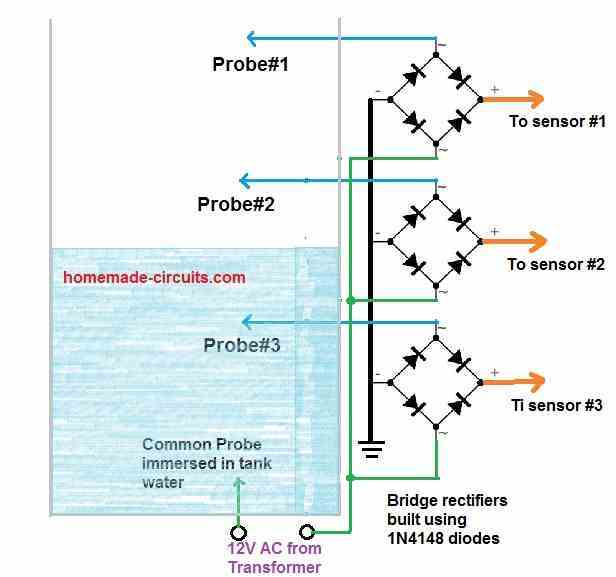
The idea is actually very simple but very effective and cheap. A bridge rectifier circuit using 1N4148 diodes can be seen associated with each of the sensing probes.
One of the AC inputs of the bridge rectifiers are used as anti-corrosion probes for sensing the water level inside the tank, while the other AC input connections are made common for applying the 12V AC.
The other 12V AC terminal is used as the common terminal immersed inside the tank water.
The alternating current from this common wire passes through the water and hit the probe#1, probe#2 and probe#3 sequentially as the water climbs up in the tank.
This causes the AC voltage to pass through the respective bridge rectifiers and convert into DC across the relevant bridge rectifier outputs.
These DC outputs are then sensed by the attached electronic water level sensor circuit for switching ON or OFF the relevant relays or transistors.
Since an AC is used across the input probes, the probes remain perfectly immune to corrosion and thus the circuit works as an ideal anti-corrosion water level sensor circuit.
NOTE: PLEASE REMEMBER TO PUT FILTER CAPACITORS ACROSS THE BRIDGE OUTPUTS AND GROUND, TO FILTER THE AC TO PURE DC, AS SHOWN BELOW:
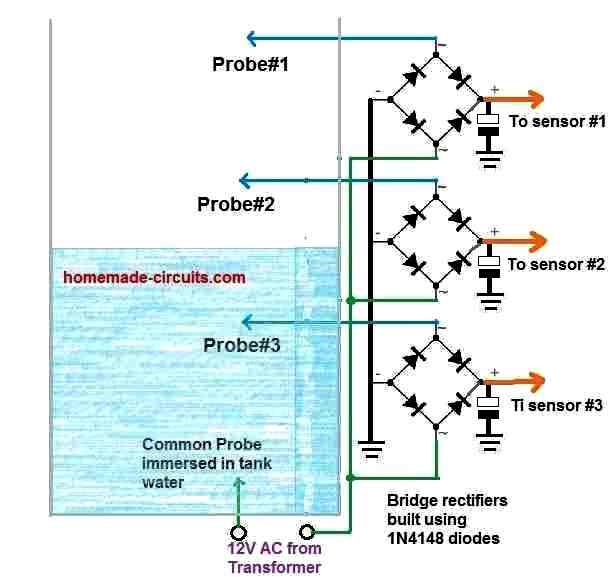
Using OR Gates
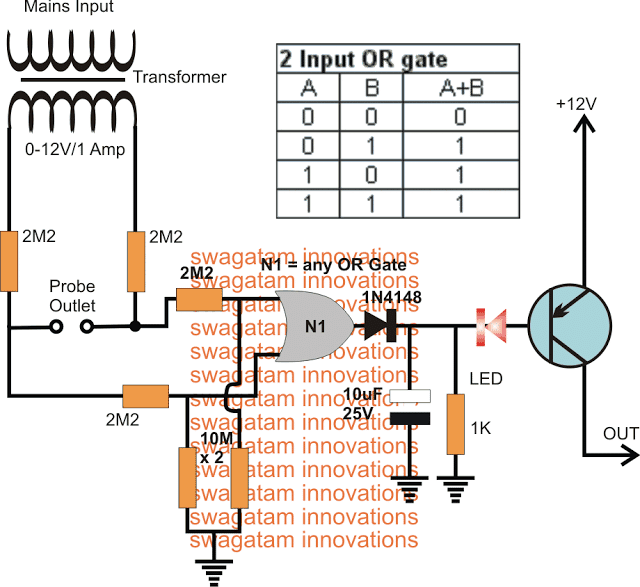
How it Works
So I have explained the above concept used for designing this anti-corrosion probe circuit for water level sensors and controllers.
Corrosion in water level sensor probes take place due to DC supply which is normally used for triggering the probes through water. This is aggravated by the process of minor electrolysis across the probe terminals which in the long term usage results in formation of layers of chemicals an minerals, gradually inhibiting efficient working of the probes and affecting the water sensing ability of the circuit.
To remedy this an AC supply is recommended so that the process of electrolysis is unable to develop across the probes due to the constant flipping of the supply polarity across the probes through the alternating nature of the supply.
In the design presented above, the AC supply is derived from a 12V transformer, via a couple of high value resistors for dropping the current across the probes.
The supply is carried forward to the inputs of an "OR" gate which specifically deals with this AC and produces the relevant output depending on whether water is present across the probes or not.
In the absence of water the applied AC generates alternately changing potentials across the two input pins of the OR gate. As per the truth table of the OR gate, a 0 and 1 or 1 and 0 on its inputs correspondingly creates an output of logic 1. This implies that while the alternate switching is applied over the two inputs of the OR gate, causes its output to consistently be at a logic 1.
Now if water happens to bridge the probe points, it instantly causes a relative short across the points causing the AC to disappear at the inputs of the OR gate.
In this situation both the inputs of the OR gate is held at logic 0, which causes its output to revert from logic 1 to a logic 0.
The above action switches ON the PNP transistor enabling the output to trigger the intended load such as a relay or an LED.
More number of gates could be employed with parallel probes points at different depths of the water tank in order to sense the various levels of the water if required, for building a multi water level anti-corrosion sensor probe circuit
The OR gate IC could be a IC 4071 or any other similar.
Another Design using IC 4093 NAND Gates
The impact of electrolytic corrosion between the liquid and the metallic sensors is an unpleasant disadvantage of several liquid level sensors. Metal electrodes are susceptible to corrosion, which results in a loss of efficiency (lower conductivity), necessitating their replacement at regular intervals.
A way to solve this is to guarantee that the sensor electrodes have an AC voltage instead of a DC potential. The electrolytic reaction is greatly slowed by the continuous change of electrode polarity, resulting in a significant reduction in corrosion.
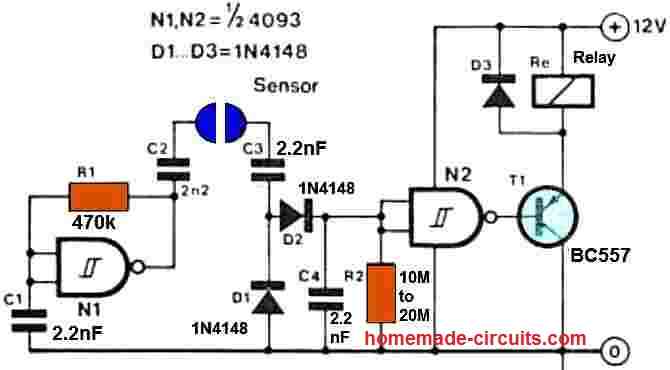
The level sensor's fundamental working is relatively basic. An oscillator is formed by the circuit that surrounds N1. C4 will be charged up through the AC coupling capacitors (C2 and C3) and the diodes as soon as the two sensors are submerged in water, and the output of N2 would be pulled low so that the relay will be activated after a brief period.
As an example, the relay could be used to activate a pump, which then regulates the liquid level. Once conductive link across the two sensors leads is removed, C4 discharges through R2, causing N2's output to become high and the relay to turn off.
Simple Corrosion Free Water Level Sensor Circuit
The following figure a possible simpler method of creating a corrosion free water level sensing terminals.
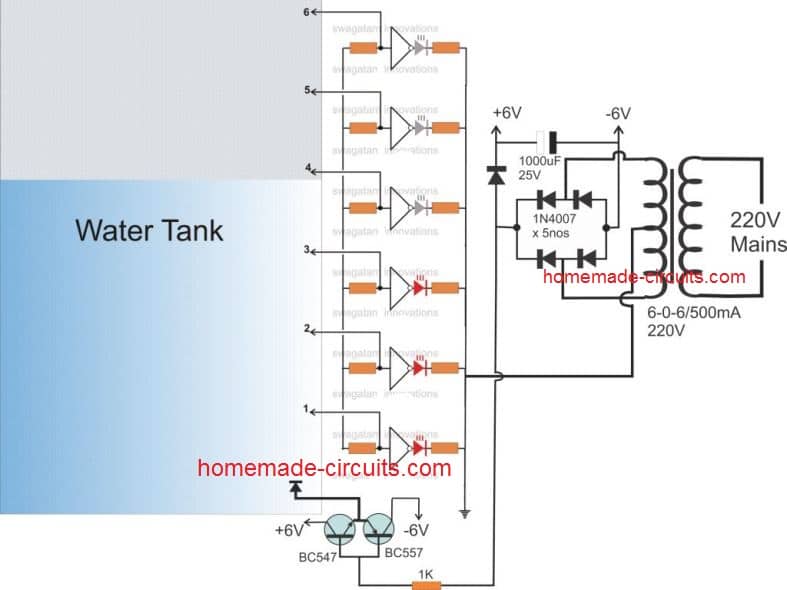
NOTE: Please connect a 100K resistor between base/collector of BC557 transistor, otherwise it will not respond to the base 100 Hz switching
In the diagram we can see that the reference ground terminal at the bottom of the tank is supplied with an alternating +/- 6V instead of a normal DC. This forces the other terminals to conduct in a push-pull manner with the reference to this base terminal and this hopefully prevent corrosion from developing across the connected water level sensing terminals.
Using Opto Coupler
A perfect corrosion free water sensing probe can be built using an opto-coupler stage between the probe and the controller circuit as shown below:
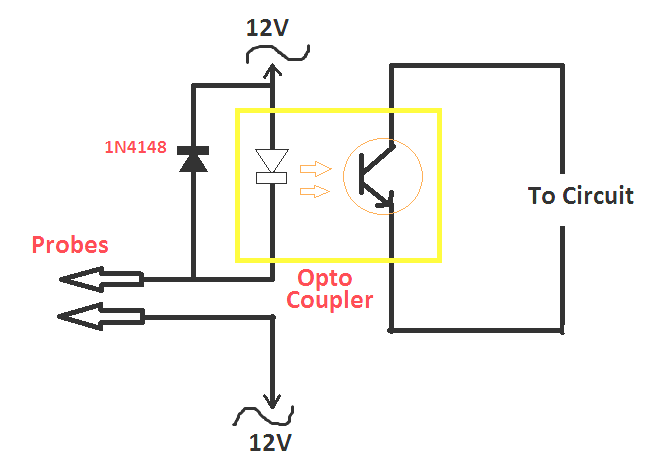
As can be seen the probes are applied with a 12 V AC through the LED of an opto-coupler, and a reverse diode. One half AC cycles pass through the water and the probes by means of the opto LED, which triggers the controller circuit, while the other half AC cycle flows through the reverse diode.
The continuously reversing cycles of the AC ensures that no electrolysis of water is able to happen across the probes, which prevents any form of oxidation or corrosion development over the probes.
hola amigo muchas gracias por los diagramas, son muy interesantes quiero fabricar uno de ellos y pide que se haga un puente con 4 diodos 1n4148, la pregunta es haya como hacerlo con un puente directo de 1 amp. o es necesario hacer con los diodos 1n4148 gracias por la respuesta
You are welcome Fantasma,
I would recommend using 1N4148 diodes since they are sensitive and will respond even to very low current inputs.
Dear Mr Swagatam, Greetings,Thank you for the information on the construction of water level sensor. Pls Sir I want to know if these circuit can also be used in waterboiler/steam generator to cut off electricity supply to heating element when the water get below a certain level to protect the heating element from damage due running dry when the water level go low
Thank you oderinde, for your interesting question!
Yes, any standard water level controller which can sense current through water can be used for your specific application.
Let me know if you need any further information or help about this application.
Dear Mr Swagatam
Greetings,
Needs your permission to use your ideas of corrosion free probes of my home ???? water control management.
Thanks and Regards
Muhammad Latif Mughal
Hi Muhammad,
You can use the above ideas for your home water control management.
Thanks Sir
Regards
Hye!
Thanks for posting these awesome ideas ????
My comment is on the Opto-Coupler circuit, that of what ampere the 12v transformer is enough for probes?
Thanks Param, the transformer rating can be 500 mA or 1 amp
Greetings..!!!
Dear Swagatham,
Regarding the new update of anti corrosion probe we cant use smd type bridge rectifier module.only 1n4148 bridge.Its so space consuming.better go for one with opto coupler its excellent also total isolation and works fine.Thank you..!!!
With Love
Dr.Sison
Thank You dear Sison,
I appreciate your kind feedback and updates.
All the best to you!
Cheers!
Greetings…!!!!
Hi Dear Swagatham,
Finally find the error in new update of corrosion free water level indicater with 1n4148 bridge.The problom is we have to connect +ve out of bridge to +ve supply of 4049 circuit and _ve output of bridge to triggering pin(probe) of 4049.Then its work fine.anyway Thanks alot for such a super simple idea.Appreciate great effort.
With ❤????????????
Sison.
Thank you Sison, for your valuable update,
However I am afraid that’s not how a bridge rectifier is supposed to work. Did you try placing the probes 1 inch apart in water, and measure the bridge rectifier output with a Dc voltmeter.
You can try the following setup to measure the output from the bridge rectifier. And I think 1N4148 would be more suitable in this setup:
" rel="ugc">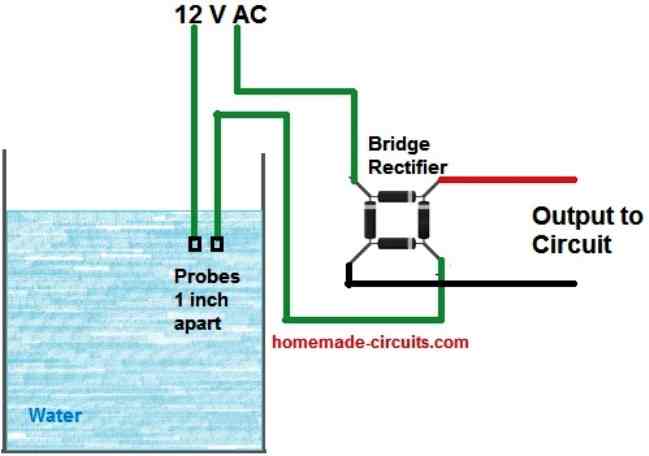
No need for 1 inch..more than one or several inch will work perfect.morover the output voltage is @10volt when using 12v 250 ma transformer.hope you will update the picture(circuit) aaap.
Thank you…Swagatham.
That’s great Sison, thanks for checking!…so i guess the 10 V DC will be enough to trigger ON the 4049 inputs or any other water level controller circuit input.
Greetings..!!!
Dear Swagathem,
This is regarding the new update about anticorrosion probe using the bridge rectifier(4148).But when i connect to existing 4049 water level indicator unfortunately its not working.but when removing new update…its working properly also its work excellent with opto coupler circuit.The idea is so amazing but dont know why its not working.please do needfull and help us the readers.
With..❤❤❤
Sison
Thanks for the update Sison,
Before connecting the bridge rectifier outputs to the 4049 IC inputs did you check how much voltages the bridge rectifier outputs is actuality generating?
Please check the bridge outputs with a DC voltmeter and make sure it generates at least 5 V DC in response to the 12 V AC in water.
Also please make sure the other 12V AC common terminal is positioned as close as possible to the sensor probe terminals inside water. This will help the AC supply to reach the bridge inputs with highest possible power.
Will try and update you soon…
no problem!
When i connect the new update do i need to remove 104 capacitor from 4049 circuit?
You can keep the 0.1uF capacitor at the 4049 gates. No need to remove it.
Greetings…
Dear Swagatham,
Regarding the new update of anti corrosion probe of water level …can i use__smd bridge rectifier module_
instead of making 1n4148 bridge rectifier? And can replace 1n4148 by 1n4007 diode?
With ❤????????
Sison
Hi Sison,
Yes you can use SMD bridge or any other type of rectifier bridge.
You can use 1N4007 instead of 1N4148, but 1N4007 will consume a lot of space.
Greetings…!!!!
Hi Swagatham,
Its so amazing that you introduce further update and simplify the corrosion free probe by bridge rectifiier and 12volt tranaformer…its Really amazing..!!!.Hope this can directly attach to existing water level indicator with 4049 ic from yoir previous circuit.Morover can use 12 v 250 ma transformer?hope this can easly attach to any water level controller too right?
From Kerala with..❤❤❤❤
SISON.C.S
Thank you Sison,
Glad you liked the new concept!
Yes it can be directly attached to 4049 circuit or any other similar water level controller circuit.
The transformer can be any 12V or 6V transformer rated above 50 mA
Greetings
Hi Dear Swagatham,
According to your opto coupler circuit can i connect 12 volt ac directly to water?im using 0..12v 500ma transformer.And the output of transistor emitter paralleling and can use for different switching of various levels on its collector?
Hi Sison,
yes certainly you can do that. Just make sure to add a 1K resistor with the lower connection of the 12V AC so that the diode and the LED can remain safe in an event of an accidental shorting of the probes.
If you parallel the opto couplers, make sure to add a 1N4148 diode individually with each emitter of the opto transistors.
Dear Swagathem,
This circuit working excellent at 12 v ac.appreciate good effort such a desighn.
Sison…????????❤❤
That’s great Sison, thanks for sharing the info!
Dear Swagatam,
The sensors I am dealing with are contact-type water level sensors. I am trying to make probes using optocouplers, but your diagram is unclear. Could you please send me the complete diagram?
Hi Prabhakar,
Can you please tell me what is not clear to you in the last opto-coupler based design??
I am using a 555 timer chip and transistor to operate an automatic water level monitoring circuit with an ac washing machine water valve attached to a garden hose port. The copper wire I am using for the probes for now tend to get a dark deposit on them after sitting in the water. I will remove them and sand the copper smooth again. The circuits I have seen on this page use gates and ac current through the probes to slow down or eliminate the electrolysis that takes place with dc on the probes from pins 2,6, and 8 of the chip. Is there a way to protect the probes without using the gates or ac through the probes?
Adding an AC to the robe can be a lot difficult, and it can make the circuit too complex, you may require optocouplers as shown in the last diagram. I would rather suggest tin plating the copper through a high grade 60/40 solder wire and soldering iron, this will help to keep the contacts corrosion free.
I do have solder that came with my soldering station from Amazon, How am I to know this is a high quality solder as opposed to run of the mill cheap but useable type? The roll says Sn99, and 3cu0.7 and ROHS2.0 that doesn’t tell me about it’s quality.
Normally a good quality solder will be lustrous and shiny, will generate less smoke, melt quickly and sometime they may be scented also….so basically a good quality solder will look silvery and shiny once coated over a desired surface
Hello Swagatam ji,
Nice work !
Does this circuit remains safe if any leakage current occured in water ? such as main pump current/earthing faults or else.(ultimately, reliability also matters)
Thanks Atul,
According to me the probes will not get affected from voltage leakages from the pump or any other external interference. Nevertheless, this can be only confirmed with a practical testing.
My comment is not on THIS opto-coupler circuit but on a similar one. Before I surfed onto your page, I found a water level circuit using a uln2004a Darlington pair IC. The brain power is 12vdc with + on pin 9 and – on pin 8. Pins 1-7 are inputs with a 47k series resistor. 12v + is sensor(s) common lead. Outputs 10-16 go to an LED with series 1k resistor to the 12v +. I substituted the 1k resistors with a 5vdc relay and it worked perfectly. My problem is the corrosion on the sensors. Sensor current was 26 uA
Could I substitute a 24vac xfmr and put a diode-resistor circuit across the input of my sensors to conduct the negative 1/2 cycle? If yes, should I start with a 100k pot and dial it down so that reverse current matches forward current that goes thru sensor input?
Yes you can use 24V AC through a resistor, and add opposite diode across the opto coupler LED. I could not correctly understand the connections that you have explained. I believe the connections should be exactly as given in the last opto couoler diagram.
Thank you, if it works I will draw an exact sketch and send it to you. :-))
Sure, no problem!
hello sir, please provide full schematic of opto coupler ic cicuit, how can i replace with carbon sensor, i am having a three sensor motor on off device.
thanks and regards.
Hello Nitin, you just have to connect a transistor stage at the output of the optocoupler, and a relay at the collector side of the transistor. Also make sure to add a 100uF capacitor across the base/emitter of the transistor.
Regarding the optocoupler variant an RC circuit has to be considered in serial to the probes. The resistor must prevent the diodes from burning at SC of the probes and the capacitor must filter the DC component, as the voltage over the LED and the diode are not symmetrical.
Hi sir,
I have made simple 12v dc powered water
level controller by using BC547. After switch. On the device it works properly. And i found stray volage in my water tank. Kindly suggest how to prevent the stary voltage in my water tank.
Hi Prasanth, at which points did you measure the stray voltage?
Hi sir, thanks for your response. I have not tested by any instrument . But I have inserted my hand in water tank and i felt the electric shock in water. (Note :- i had taken 12volt DC current from normal 12v dc adapter to my circuit)
Hi Prasanth the “shock” feeling may be due to AC mains leaking from the transformer body. Please make sure that you have a good earthing in your mains socket, and connect the transformer iron body with the earthing line…if you are using an SMPS, then connect the negative line of the circuit with the earthing line.
Hi,
it is a nice article, so thanks for it.
I wanted to know that if in any worst case, there is possibility of current leakage from primary coil to water tank, due to any reason like transformer failure or some thing that I might not know.
In that case what safeguards should be used.
Thanks
Hi, Thank you, glad you liked the article. There’s no chance of mains entering the water, unless the transformer is of bad quality, and/or the mains voltage increases to a level that burns the transformer winding.
Hi swagtam, i have created the circuit using bc547, 22k at base and 5 volt supply. With 22k and 5 volt the probes are seems very less corrosive. Now the problem is the circuit is high sensitive. What should i do to decrease the sensitivity so that the led will glow only when the probes dip in water?
Hi Chandrashekhar, which circuit are you referring to?
Sorry this is not circuit tht i am talking about. The circuit is in simple water level monitor using bc547 forum. By the way the problem is that. Pls any solution?
Add a 0.22uF capacitor across base/emitter of the transistor
Dear Swagatam,
I have just read your article and tried to build the second circuit, but unfortunately it dosent work as expected. Following i shat i have done, please correct me i have done something wrong.
I am using 4049 ic for not gates.
I am using 6-0-6 transformer.
I have connected middle wire to ground.
I have connected positive out from capacitor to collector of 547 and first pin of 4049 ic.
I have connected negative out from capacitor to collector of 557 and pin 7 of 4049 ic.
I have used common base of both transistors as a common wire in water tank.
Thanks in advance.
Imran Baig
Dear Imran, yes that looks OK to me!
Dear Swagatam,
Thank you very much for replying my question, let me tell you more that i have also connected a 100K resistor between base to collector of BC557 transistor as suggested, but still the circuit dosen’t works for me, can you please share your email address with me, so that i can share the exact circuit diagram which i have made, to rectify the mistake.
Thanks in advance,
Imran Baig
Dear Swagatam,
Thank you for the reply, I am trying to build the electrolysis-free automatic water-motor ON\OFF switch having 4 LED water levels indicators for my home water tank. For the first step i am trying to glow the LED with this circuit and then in next step i want to ON\OFF the water motor based on minimum and maximum water level.
Best Regards,
Imran Baig
OK, in that case you can test the first circuit as suggested by me in the previous comment. Make sure the +/- pins of the IC get the 12V, and also the emitter of PNP. As soon as water touches the probe points, the gate input pins must become 0V, this will cause the output of the gate to become 0V too, and the PNP will conduct along with the LED.
The DC 12V to the IC can be acquired from a bridge rectifier and filter capacitor from the same transformer. The transformer can be a 500mA rated.
After immersing the probes under water check the voltage across the 10M resistors, it must show 0V here.
Ok, i will try to build the first circuit again and will let you know about the results. Please tell me where to connect the collector of PNP transistor which is marked as OUT.
You may keep it open initially, and watch only the LED response. Once the LED response is confirmed you can connect the collector to any desired load such as a relay.
Dear Swagatam,
I have created the first circuit on breadboard as suggested, specified below are the detailed observations and the steps I performed.
– The initial voltage of my transformer are around 13.5 volt AC.
– When I converted AC to DC using bridge rectifier and a filter capacitor then DC voltage becomes around 17.5 volts, so I used Regulator IC 7812 to get exact 12 volt DC.
– I have assembled the circuit on breadboard as suggested. I didn’t have 10M resistors so I have used 2.2M resistors to ground the input of OR-Gate.
– I have connected IC 4071 pin-7 to ground and pin-14 to +12 volt, I have also connected emitter of PNP BC-557 transistor to +12 volt.
– With open probes the voltages on input of OR-Gate are around 3.5 volt AC.
– With short probes the voltages on input of OR-Gate are around 0 volt AC.
– With open probes the voltages on output of OR-Gate are around 2.5 volt DC.
– With short probes the voltages on output of OR-Gate are around 0 volt DC.
But unfortunately the LED didn’t glow neither with open nor with short probes.
I think the problem is around LED and transistor. I have also connected LWD in parallel to diode 4048, and it works as desired, please correct me what wrong i am doing.
Thanks in advance,
Imran Baig
Dear Imran,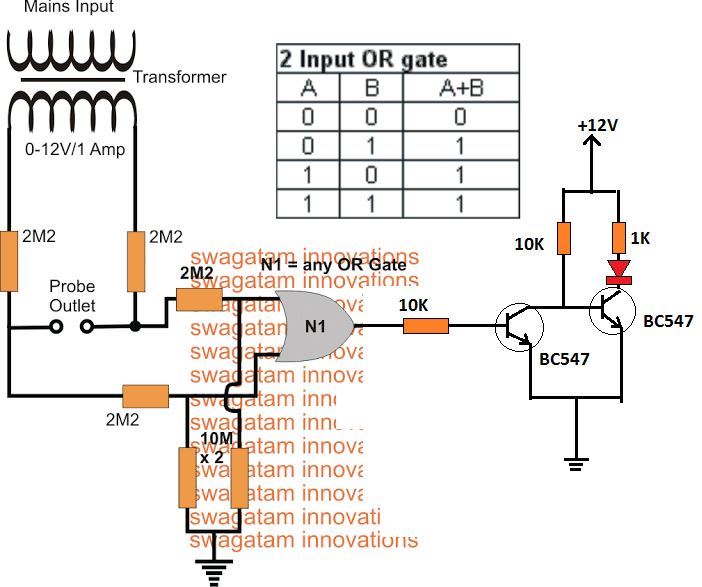
Thank you for the detailed explanation.
Please modify the output section in the following manner, and let me know how it works.
" rel="ugc">
Just wanted to know that did you check the results by actually putting water across the probes??
If you connect the LED directly across output of the gate and the ground then the LED will illuminate when water is not present, but we want the opposite results from the LED, therefore we’ll have to add the specified NPN BJT stages.
Dear Swagatam,
Thank you very much for reading my response and replying me, I will definitely modify the output section and will let you know about the result.
Answers of your questions are.
– Yes I have checked the result in both ways, by directly short-circuiting the probs and by putting the probs in a glass the water.
– Yes you are right, when i connect the LED directly across output of the gate and the ground, i get the result but in opposite order, I will experiment the suggested NPN BJT stages for it.
I have couple of question; as you suggested that for each indicator i will have to put two probs parallely into the water on one inch distance. can i combine one prob of all indicators to get one common brob, because i have less wires to put into the water tank.
Secondly will this circuit work for long distance wires; like 40 feet or so? as i have a water pump at ground floor and the water tank at third floor roof top, and i want to place entire circuit on ground floor near water pump.
Thank you for your help,
Imran Baig
No problem dear Imran, Let’s wait for the results.
Here are the answers for your other questions:
Two wires for the probes will give foolproof results since the current has to pass through a very short distance across the probes, whereas using a single common wire for one of the probes will mean the current has to pass through a big bulk of water affecting the reliability of the results. You can use twin joined wire cords for each pair of probes to simplify the wiring.
Yes you can use long wires without issues, just add a 0.22uF capacitor across each gate input and ground, to eliminate interference pickup.
Dear Swagatam,
I tried the modified circuit last night, but still no luck. The LED connected with the collector of second BC547 transistor keeps glowing in either case, whether I open the probes or short the probs. Meanwhile I have also connected LED with ground and output of OR gate and it works as earlier.
Best Regards,
Imran Baig
Dear Imran, If the LED alone responds to the water contact then the transistor has to also respond. Please shift the LED in between the Gate and the transistor base, and also reduce the base resistance to 1K and check again. This will prove the actual situation of the transistor conduction.
Sure i will do it, and will let you know about the results.
OK great!
Dear Swagatam,
I have modified the circuit as suggested, and have connected LED + 1K resistor between output of OR gate and base of first 547 transistor, the LED gets ON with open probes and gets OFF with short probes, I also noticed the result of second LED which is connected between +12v and collector of second 547 transistor having 1K of resistor in series. This LED still behaves the same; means it remains ON in both conditions.
Apart of this I was thinking about using NOR gate instead of OR gate, and have also experimented it last night. I have used ic 4001 for it, with the same input of gates, and the only LED connected between output of NOR gate and ground. unfortunately it also didn’t worked for me, the LED remains ON in both of conditions.
Best Regards,
Imran Baig
Dear Imran, it seems there’s something wrong with the second transistor. If the LED is glowing it means the first NPN is conducting, in that case it is grounding the base voltage of the second transistor, so the LED at the collector of the second transistor must shut off. Please check the base/emitter voltage of the second transistor, if it becomes zero and still its collector LED glows then the transistor may be faulty or wrongly connected.
I have also tried to build the first circuit as well but again no luck, definitely i am doing some mistake. I have some questions regarding first circuit as listed below.
– Can i use “500 milli-ampare” transformer instead of “1A”?
– Can i connect bridge rectifier and capacitor directly with this transformer to get DC 12v to operate other motor controller circuit?
– What does +12V indicator means in this circuit, do i need to give +12V input here, and -12V input to the ground specified in this circuit?
– What does “OUT” indicator means in this circuit?
– As per my understanding, “Probe Outlet” are the probes needs to be dipped in the water, if i make 4 indicators then will i need to dip two probes for each indicator means total of 8 probes, or will there be any common probe which will make total of 5 probes?
Best Regards,
Imran Baig
Please let me know what result are you trying to check in the first circuit, is it the corrosion effect or the LED illumination?
I guess it is the LED illumination. As per my understanding which I have explained in the article, when water bridges the “probe outlet” points it produces low resistance for both the half cycles of the AC from the transformer. This means the GATE input is inhibited from a positive supply, and both the inputs get 0V, when the both the inputs are zero volt the output of the gate also turns zero allowing the transistor to be biased through the LED.
Yes the probe outlets meed to be placed at the different positions of the water and must be at a 1 inch distance.
Remember the IC needs a 12V DC to operate across its Vcc and Vss pins, this 12V must also be connect to the transistor emitter.
Hello! I’m from brazil, and will try to make the first circuit.
1 – Works with 9v transformer?
2 – I’ll need a transformer and a dc power supply to do, right?
3 – if I test only one level, with 4071 I need to do something more?
Yes that’s correct! You can use a single gate from the IC, and ground all the inputs of the remaining gates in the IC, the outputs of these gates can be left open.
Also, replace the 2M2 resistor connected with the transformer 12V wires with 100K for better response!
hello, please help how to using anti corrosion probe with arduino for water level control.
You can use the same concept which is shown in the second diagram. Or more simply, just introduce one wire directly from the transformer secondary into the water. This will create an low voltage AC in the water prevent the corrosion effect.
Hi
This water level controller circuit is very simple and maintenance free.
Bro i want to add high and low level alarm, i know its easy, but the reason i asking is that i want to use only one bell type switch which can reset both high and low level alarm when tank water is full or low.
Is it possible, could you please help me out.
Thank you Avi, yes you can achieve it by using the concept explained in the following article:
https://www.homemade-circuits.com/2015/09/borewell-motor-pump-starter-controller.html
IC1 or IC2 both are monostables circuits which produce a high output for sometime depending on the values of the C and R, in response to input triggers. You can use any one of these circuits, and connect the 0.22uF with water controller outputs through separate diodes (1N4148). The anodes of both the diodes will join with the 0.22uF end, while the cathodes will separately join with the upper and the lower water level IC outputs. The relay contacts can be joined with an alarm.
Hi
Sorry to bother you again but
wow bro that is really simple and amazing. I understood when top most led will trigger the delay on circuit for the time depending upon c and r value. But i didn’t understand when water will go down the 2nd led gets turn off how it will trigger the circuit again.
Also is it not necessary to connect a reset switch for alarm.
Hi Avi, you can actually do it in the following manner:
https://www.homemade-circuits.com/water-level-alarm
No need of any reset switch
Sorry Avi, I think I am wrong this will not work, I’ll try to think of some other alternative.
Hii
bro an idea just stucked in my mind to make it possible. I think by using an two separate diods, spdt switch and a transistor not gate connected at the low level output from indicator.
Hi Avi, but it should be automatic right? so switch cannot be used, here’s the revised diagram, this will do the job perfectly:
https://www.homemade-circuits.com/water-level-alarm-2
the diode ends will go to the respective NOT gate outputs
Dear sir, In the main article N1 is given as any or gate. Which IC can be used. 12V dc can be connected to DC supply for that IC. Which Transistor is to be used. it is not given. Then in the simple corrosion free water level circuit , the IC no. is not given.Why the power supply should be 6-0-6 volt supply. can it be 6v or 12v DC . in this case only one transistor (547 OR 557) may be sufficient. pl clarify. When the maximum components details are given, certain data such as IC type and like resistor values are not given. Request your comment.
Dear Loganathan, you can use the IC 4071B, and use one gate out of the 4 gates in it. Make sure to ground all the inputs of the unused 3 gates. The transistor can be BC557 or ant similar.
Sometimes I may forget to add the component number, but you can always ask me to update the missing ones, I’ll do it quickly.
In the second design if the transformer is single polarity type then the anti-corrosion effect will not work, it has to be dual or push pull in nature
Hello sir Swagatam,
I stumbled upon this link in the response you gave to a question of the main article. I assembled the the circuit in the main article and it worked quite well. But I assembled and tested it in a small water container. Thank you for providing the circuit above to solve the issue of corrosion. I want to wire the last circuit with just four levels and not six. My questions go thus:
1. Can I use the circuit in a water tank that is about 3-4meters in height and get a good result, knowing that the distance between the probes will be much? If yes,
2. Do I put the “base probe” which is from the BC547 and BC557 at the base of the tank and put the other four probes at their respective positions or will each of the four probes have their own “base probe” beside them for better response?
3. Is the IC still 4049 or another?
Hi Godson, glad you could build it successfully.
here are the answers:
1) yes you can use ti for deeper tanks since the use of a frequency makes the conduction sharper and long ranged.
2) You mean to say the emitter probes? Yes the probe is required to be placed at the bottom of the tank
3) The IC is 4049.
Hello sir Swagatam,
Thanks a lot for the response. Yes I meant to say the emitter probes.
I have more questions from the second schematic above:
1. The 2M2 resistors are not connected to the positive rail of the supply as against what is in the main article. Is that an omission?
2. The center-tap of the transfo is connected to the ground. Is it the same ground that is supplying the 4049?
3. Can a 12-0-12 transfo be used in place of the 6-0-6 transfo?
Hi Godson,
thanks for pointing out the mistake.
1) the 2M2 resistors must be connected with the positive supply, it has been mistakenly missed
2) yes the center tap ground is common for the IC negative terminal, and the rest of the circuit where ground symbols are indicated.
3) 12-0-12 transformer can be used
Hi Swagatam
Just a short note to convey my appreciation for the effort that you put into your very enlightening articles.
As a semi-retired mechanical engineer, I have really benefited from your excellent articles and have as a result, successfully built several practical circuits. I look forward to building many more once I retire.
Many thanks
Kind regards
Peter Bestbier (Cape Town South Africa)
Thank you Peter, The pleasure is all mine!! keep up the good work.
Dear sir,
I have simply used electronic bell (3V Dc supply) inputs as water level sensor inputs & a switch in series (used when borewell is on).
It worked well for some months but now its not giving proper alarm on tank being full.
i have changed batteries as well as filed the tips of copper wires used as probes but problem persists randomly.
what could be possible fault.
Dear Shry,
how did you place the probes? make sure the distance between the probes is minimum, may be around an inch apart, now place this set of probes at the brim of the tank for sensing and check the response…
SIR ..if water reaches at prob and stil water is there transformer will not got dammage??
2ndly is or gate ic read the ac signal …morever its a digital ic? so how is it possible??
Hi Abubakar,
transformer will not get damaged because the transformer is not near the water, only its output is immersed in water that too through 2M2 resistors.
An AC is made up of two alternating DCs, right?, therefore applying this AC will be like applying two alternating DCs at the gate inputs….therefore the working will be perfectly OK just as explained in the article…